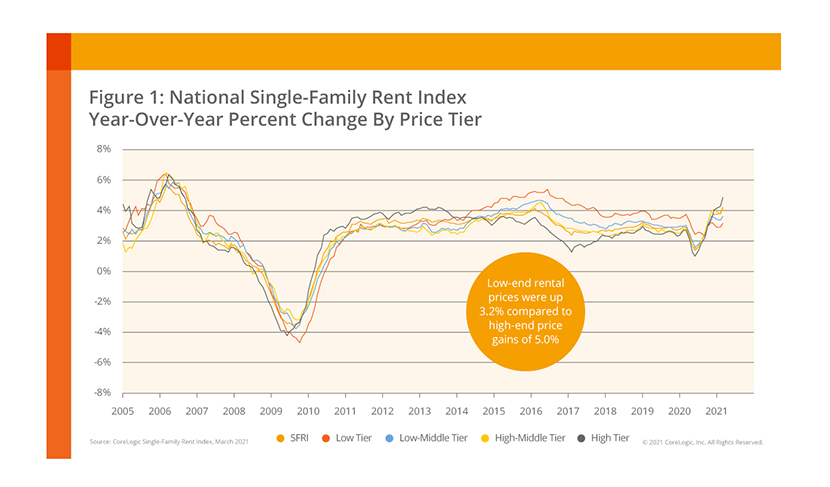
Strong Demand Fuels Single-Family Rent Growth

Chart courtesy of CoreLogic
Occupancy rates for single-family rental homes have reached a generational high, driving up SFR rent growth, two new reports said.
CoreLogic, Irvine, Calif., reported single-family rent growth reached 4.3 percent in March, up from a 3 percent pace a year ago.
Molly Boesel, Principal Economist at CoreLogic, said the rent growth indicates a “preference shift” from multifamily apartment communities to standalone properties as renters seek more space in less dense areas. “Prior to the pandemic, rents for detached properties and attached properties grew at similar rates,” she said. “However, starting in June 2020, rent growth for detached properties accelerated and by March, grew at five times the rent growth rate of attached properties.”
Arbor, Uniondale, N.Y. said SFRs are starting to fill the role that starter homes played for previous generations and noted professional residential operators are “racing” into the sector.
“All else equal, 2020 proved a banner year for the SFR sector,” Arbor said in its first-quarter Single-Family Rental Investment Trends report. “Before a real estate product type withstands its first recession, it is impossible to know for sure how it will perform during a downturn. The theory before the pandemic was that SFR was as recession-resilient as they come and the past year confirmed just that.”
Arbor said loan-to-value ratios on SFR mortgages fell in the first quarter, sliding 50 basis points to 59.9 percent. “While LTVs do tend to fall during recessions, the current decline is unique,” the report said. “Historically, a recessionary dip in LTVs would be caused by falling asset values, which, in turn, would prompt lenders to build in higher equity cushions to guard against potential defaults. In the current market, the continued downward pressure on LTVs is more reflective of accelerating asset values and modest conservatism from debt providers in a period of bullish volatility.”
CoreLogic said higher-priced SFRs are seeing the most rent growth. Assets with rents priced at 125 percent or more of the regional median saw 5 percent rent growth in March, compared to 3.2 percent for properties priced at 75 percent or less of the regional median.
“In the next few years, the SFR sector will mature into a period of linear growth from the non-linear trajectory that has categorized 2019 and 2020,” Arbor said. “However, that transition is highly unlikely to happen in 2021. The sector shows no signs of slowing down, as short-term economic factors and long-term demographics both support a step up in demand for professionally managed single-family housing units.”
